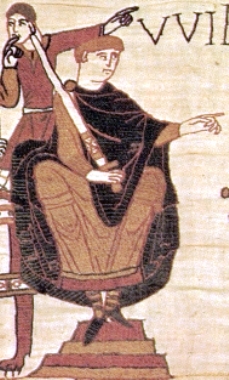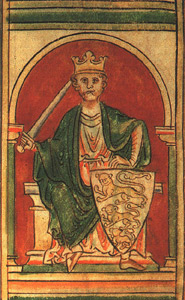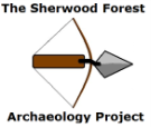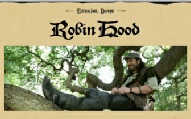In 1066 William ‘the Bastard’, Duke of Normandy became King of England following victory at the battle of Hastings over the English King Harold Godwinson.
It wasn’t really a fair fight-

Picture: William the Conqueror, King of England.
These events followed a dispute over the English crown following the death of Edward the Confessor. William believed the crown had been promised to him and that Harold had betrayed him.
Following his victory William was crowned at Westminster in London.
This brought to an end the chaotic preceding period where a mixture of ‘Saxon’ and ‘Viking’ kings had fought over and ruled England for centuries. These Kings included such colourful sounding characters as: King Athelstan, King Cnut, Harold Harefoot, Edmund Ironside and Aethelred ‘the unready’, and lesser characters such as Ivan the Boneless and Sven Forkbeard-
During his reign the entire ownership of England altered with all the land now belonging directly to the King. William then distributed this land to favoured followers and so on down the chain.
This was often for political and tactical reasons.
Locally he gave major land holdings to two significant Barons: William Peveril; who owned a large grouping of manors known as the ‘Honour of Peveril’ in the south and west of the county, and Roger De Bully whose possessions covered most of the north of the county; centred on the Castle of Tickhill, called the ‘Honour of Tickhill’ (more on Domesday landholders soon).
In order to raise taxes-
The Domesday Book was a staggering undertaking listing every manor and vill in existence at the time, along with the amounts of taxable land, woodland, arable, pasture, meadow, mills, cottages, oxen, ploughs and men-
William brought with him the forest law that is the basis of our story in Sherwood. We have no first hand record of the forest in Nottinghamshire from the reign of William I, but William did found the New Forest in Hampshire at this time.
William died in 1087-
William and his Norman compatriots were always Norman at heart, and now owned lands either side of the channel.
This French bias of the Norman rulers (and later the Plantagenet dynasty), and the ownership and disputes over territories in France that it caused, shaped the politics of England throughout the medieval period.
William Rufus (because of his red face and hair) William the conquerors 3rd son inherited the throne on his death, as William II (1089-
William was given the conquered lands as the younger son-
This division of the Norman and English lands under different rulers was to prove a difficult situation for Kings and Barons alike, leading to the loss of Normandy under King John in the early 13th century, and eventually to the Hundred Years War of the 14th and 15th centuries.
Outright war was avoided, and William II eventually bought the Dukedom from his brother Robert who needed the money to go on crusade.
Passionate about hunting, William was killed in a hunting ‘accident’ in the New Forest in 1100… and his younger brother Henry was quick to have himself crowned in his stead in 1100.
Picture: The death of William Rufus.
Henry I fought his brother Robert for the Dukedom of Normandy and won it at the battle of Tinchebray in 1104 to re-
This was important locally as the Honour of Tickhill defaulted to the crown after Roger de Belleme the successor of Roger De Bully had fought on the wrong side.
This would have a significant impact on the shape and size of Medieval Sherwood Forest (more later).
The earliest known boundary of the forest in Nottinghamshire comes from the reign of Henry I.
A brutal leader who once threw a man from the tower of one of his castles, and who fathered more than 20 illegitimate children, he is nonetheless most famous for writing ‘the Charter of Liberties’, a document binding the king to laws regarding the treatment of clergy and nobles-
He ruled for 35 years.
He married his daughter Matilda to Geoffrey Planaganet of the house of his bitter rivals the Dukes of Anjou, in an attempt to build an alliance with them.
When his son William was killed when his ship ‘the white ship’ sank in the channel, the succession of the throne was thrown into turmoil.
Henry forced the barons to accept Matilda as Queen, but the following decades resulted in a civil war that would ultimately bring down the Dukes of Normandy as the rulers of England…
Married as she was to the now Duke of Anjou Geoffrey Plantagenet, Matilda was seen as a threat by many of the Norman barons who feared having a Duke of Anjou on the throne.
They chose instead to support Stephen of Blois a grandson of William the Conqueror as king of England.
Stephen was King of England for 19 years. They were not to be peaceful ones.
Geoffrey and Matilda fought back and a civil war known as the ‘Anarchy’ ensued.
This civil war eventually resulted in King Stephen accepting Matilda’s son Henry of Anjou as his heir.
The result was that in 1154 the Dukes of Normandy were replaced by the Dukes of Anjou as Kings of England-
The Norman kings of England had therefore been replaced by the Angevin Kings… a family whose names are familiar to this day; Henry II, Richard I (the Lionheart) and King John…

Picture: Richard the Lionheart, King of England
They would have a massive impact on Medieval England, the dynasty they founded -
Their empire at the time stretched from the borders of Scotland to the Spanish Pyrenees.
They would also have a massive impact on Medieval Sherwood Forest-
(Andy Gaunt, first published 22/09/2011)
Click here for more ‘Stories from the Forest’…



Community Archaeology Nottinghamshire, Community Archaeology Derbyshire, Community Archaeology Leicestershire, Community Archaeology East Midlands, Mercian Archaeological Services Community Archaeology for Nottinghamshire, Derbyshire, Sherwood Forest, Leicestershire and the East Midlands. Community Archaeology Nottinghamshire, Community Archaeology East Midlands, Community Archaeology Leicestershire. Archaeological

Medieval Kings Part 1, The Normans: 1066-
Award Winners 2016
for "Engaging people in the heritage, history & archaeology of Sherwood Forest".





Some funders and partners:
World-











Mercian Archaeological Services CIC
Specialists in Community Archaeology, Public Involvement, Research & Training
Community Archaeology Nottinghamshire, Excavation, Research, Volunteering, Community Archaeology Derbyshire, Training, Social, Learning, Community Archaeology Leicestershire, Heritage, Involvement, Belonging, Knowledge sharing, Community Archaeology Lincolnshire, Topographic Survey, Talks and Presentations, Outreach, Archaeology Projects , Open Days, Schools, Finds Processing, Day Schools, Field Schools, Young People, Archaeology and History of Sherwood Forest, Pottery Research, Medieval, Roman, Prehistoric, Community Interest Company, Community Archaeology Nottinghamshire.
Community Archaeology in Nottinghamshire
Community Archaeology in Derbyshire
Community Archaeology in Leicestershire
Community Archaeology East Midlands
Community Archaeology in Lincolnshire
© Mercian Archaeological Services CIC 2013. Registered Business No. 08347842. All Rights Reserved.
The Future of Sherwood’s Past
Project page links:
-
-
-
-
-
-
-
-
The Sherwood Forest
National Nature Reserve Archaeology Survey
-
Long term Research at
King John’s Palace:
Ancient Royal Heart of Sherwood Forest
-
The Sherwood Forest Archaeology Training Fieldschool
-
“Scirwuda-
Ghost and Shadow woods of Sherwood Forest Project
-
Investigating Thynghowe Viking
Meeting Site
-
Searching for the
The Battle of Hatfield
-
-
Fieldswork at St Edwin’s Chapel
-
St Mary’s Norton-
-
Mapping Medieval Sherwood Forest
-
The Sherwood Forest LiDAR
Project
-
Warsop Old Hall
Archaeological Project
-
The Sherwood Villages Project:
Settlement Development in the Forest
-
-
-
Researching Edward IIs fortification at Clipstone Peel
-
-
-
-
The Cistercians of Rufford Project:
Settlement Development, Dynamics and Desertion.
-
Sherwood Forest Environmental Survey
-
World War II in Sherwood Forest -
-
World War I in Sherwood Forest -
-
About Medieval Sherwood Forest
-
Robin Hood and Sherwood Forest
-
-
-
-
-
-
-
-
-
-
-
-
Project page links:
-
-
-
-
-
-
-
-
The Sherwood Forest
National Nature Reserve Archaeology Survey
-
Long term Research at
King John’s Palace:
Ancient Royal Heart of Sherwood Forest
-
The Sherwood Forest Archaeology Training Fieldschool
-
“Scirwuda-
Ghost and Shadow woods of Sherwood Forest Project
-
Investigating Thynghowe Viking
Meeting Site
-
Searching for the
The Battle of Hatfield
-
-
Fieldswork at St Edwin’s Chapel
-
St Mary’s Norton-
-
Mapping Medieval Sherwood Forest
-
The Sherwood Forest LiDAR
Project
-
Warsop Old Hall
Archaeological Project
-
The Sherwood Villages Project:
Settlement Development in the Forest
-
-
-
Researching Edward IIs fortification at Clipstone Peel
-
-
-
-
The Cistercians of Rufford Project:
Settlement Development, Dynamics and Desertion.
-
Sherwood Forest Environmental Survey
-
World War II in Sherwood Forest -
-
World War I in Sherwood Forest -
-
About Medieval Sherwood Forest
-
Robin Hood and Sherwood Forest
-
-
-
-
-
-
-
-
-
-
-
-